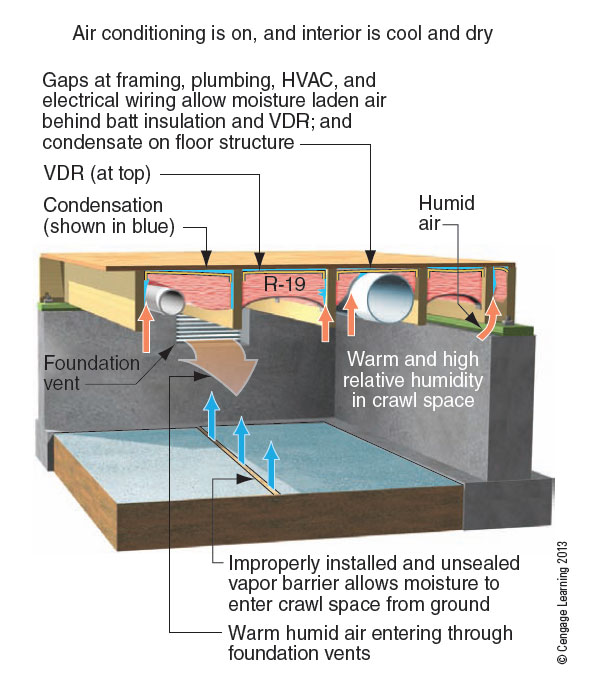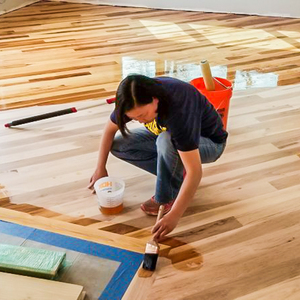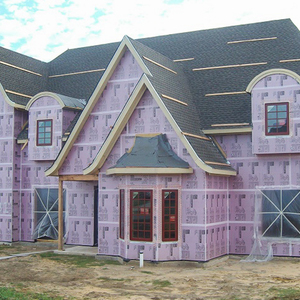Image Credit: Cenage Learning
Image Credit: Cenage Learning Using vapor and air impermeable insulation over crawl spaces helps to prevent condensation from forming. While we recognize that installing ductwork in open crawlspaces is not considered a best practice, it is still a common practice and our goal is to help professionals improve all construction methods wherever possible.
Image Credit: Cengage Learning
[Editor’s note:This is an excerpt of the “Insulation and Air Sealing” chapter of Carl’s new textbook, Green Building. Carl’s publisher, Cenage Learning, has allowed us to make the whole chapter available as a free download.]
Insulation and air sealing
Unless a house is located in paradise, where the weather is always perfect, it will most likely need some amount of heating and cooling for portions of the year. Whenever a house is heated or cooled, insulation is essential for maintaining an energy-efficient and comfortable home.
For insulation to perform properly, we must also seal the house to eliminate air movement through it. Selecting the appropriate insulation and air sealing materials and following proper installation methods is critical to creating a green home. The specific characteristics of different insulation and air sealing materials give us the information we need to make appropriate decisions for new and existing homes.
Selecting insulation
When selecting insulation, four primary factors should be taken into consideration: performance, installation method and quality, material characteristics, and cost.
Performance includes the R-value per inch, air permeability, and vapor permeance.
Installation methods include applied insulation materials that are applied to the structure, such as batts, sprayed or blown-in products, and continuous boards. Batt insulation is thermal or sound insulation material, made of fiberglass, mineral wool, or cotton, which comes in varying widths and thicknesses to conform to standard framing of walls, floors, and ceilings. Another method is to use structurally integrated insulation that is part of the structure itself.
Material characteristics address recycled content, recyclability, embodied energy, extraction and production location, hazardous components, and bio-based content. Bio-based insulation is created from plants, animals, or other renewable sources.
Cost is often one of the most difficult criteria to objectively evaluate. When weighing expenses, we must consider not only the initial costs of material but also the costs of proper installation and any additional work required for some materials to match the thermal performance of others.
Performance characteristics
Each insulation material has its own set of performance characteristics, including R-value and resistance to air and vapor flow, all of which have an effect on how it will perform in a particular installation. Understanding the characteristics of different materials is critical to selecting the right insulation for a green home.
R-Value of Insulation. The R-value per inch rating for different insulation materials is based on laboratory tests (refer to Table 2.1 in Chapter 2); however, the performance of a particular insulation in a building component is affected as much by the quality of the installation and the completeness of the air barrier as by the rated R-value.
Insulation works by limiting heat transmission through the properties of the insulating material and its thickness. When insulation is compressed, it reduces the rated R-value as the thickness is reduced, although the R-value per inch may in fact slightly increase from reduced convection within the insulation material. This characteristic is analogous to the insulation value of a down coat — it insulates better when it is thick and fluffy than when it is compressed.
Well-installed insulation of lower R-value limits heat transfer more effectively than poorly installed, higher R-value materials do. Appendix 4A on page 121 lists the R-values of typical insulation materials and where they are commonly installed.
Air permeability
Airflow is one of the most important factors affecting building performance. Permeability is the measure of air or moisture flow through a material or assembly. For insulation to properly perform, air must not be allowed to move through it. Insulation is described as either air impermeable, meaning that the material itself does not allow air to pass through it, or air permeable, which allows air to pass through.
The Air Barrier Association of America (AABA) has developed ASTM-approved test methods for air barrier materials and systems. They define an air barrier as a material or system that has an air permeability of no more than 0.004 cfm/ft2 at 1.57 pascals (1.57 Pa). Pascals are a basic unit of measurement for pressure.
Foam insulation is the only commonly available product that is air impermeable. All air permeable insulation materials must be combined with air impermeable materials into a complete air barrier system for maximum performance.
Vapor permeance
Vapor permeance in building materials, including insulation, is categorized in one of four ways: impermeable, semi-impermeable, semi-permeable, and permeable. Each of these categories describes how much water vapor is allowed to pass through the material.
In Chapter 2, we discussed vapor diffusion retarders and where to install them in building assemblies. Although we tend to avoid vapor barriers (materials that are rated at 0.1 perm or lower, such as sheet polyethylene) in wall assemblies, closed-cell foam or other vapor-impermeable insulation may be an appropriate choice where there is a risk of moisture condensing on cold surfaces. Vapor impermeable insulation is beneficial when applied to floors in air conditioned spaces over damp crawl spaces (Figure 4.1a and Figure 4.1b) or roofs and walls in extreme cold climates (see Figure 4.2).
Fire resistance
Insulation must be fire-resistant or covered with a fire retardant barrier to remain exposed in a habitable area or when combustion appliances are nearby. Unfaced fiberglass insulation may be left exposed. Foam insulation, either spray-applied or rigid boards, must be covered with a fire resistant covering to comply with fire codes.
Coverings can be drywall, intumescent paint, or, in the case of rigid boards, foil facing. Intumescent paints are fire-retardant. Some building codes allow foam to be left exposed under certain conditions, such as in attics and at rim joists. If foam insulation is designed to be left exposed in a project, you should confirm that it meets all the applicable building and fire safety codes.
Pest management
Insulation products should be selected and installed to prevent pest entry and damage. Fiberglass insulation is not a food source for pests and poses little risk. Foam insulation is another material that is also not a food source, but it can provide pathways for termites, rodents, and other pests to enter a structure undetected. Some rigid foam products are treated with borates that deter pests.
The cellular glass rigid insulation Foamglas offers the greatest termite and rodent resistance of any insulation material. This product is widely used in Europe but only recently became available in North America as a building insulation. Because spray foam is not normally treated for pests, foundation and floor applications should leave an inspection gap to ensure that termites do not have access to the building structure.
Download the entire chapter or purchase the book.
Weekly Newsletter
Get building science and energy efficiency advice, plus special offers, in your inbox.
















One Comment
Carl, bravo for this snippet
Carl, bravo for this snippet of the book.
Log in or create an account to post a comment.
Sign up Log in